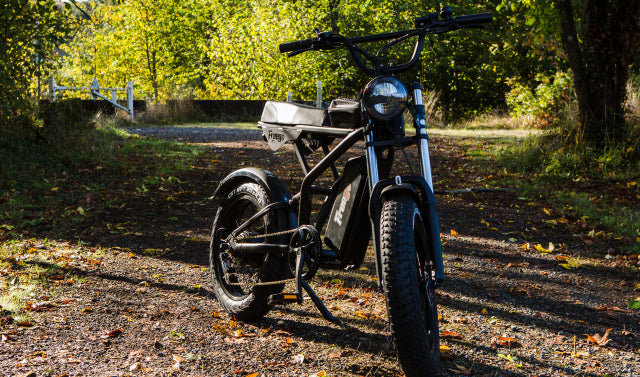
Electric bicycle battery maintenance tips
Share
The battery is the heart of your eBike, so don’t be afraid to show a little love! Without it, you wouldn’t be able to hit those long distances, climb bigger hills or avoid breaking a sweat before you get to work.
Battery upkeep is pretty simple for the most part, but the little things can make or break your battery’s life.
1. Steer away from puddles
As you may already know, water doesn’t mix well with electricity. Even though our bikes are built to endure the elements, we still don’t recommend excessive riding in wet conditions – since the keyhole, located on the underbelly of the bike’s frame, exposes the battery. The component most at risk to damage in this situation is the display. The other components (battery, controller, motor) are much better protected.
It’s important to note that our bikes’ IP-65 rating makes them water resistant, not waterproof, but don’t panic if you find yourself in a rainstorm. In most cases, the IP-65 rating should keep you covered from the time it starts raining to the time it takes you to find cover. At the end of the day, every rider’s circumstances will vary, so just try to use your best discretion and remember that everything is done best in moderation.
2. Adapt to your environment
As with any mode of transportation, it’s important to be well equipped and cognizant of your surroundings. Extreme climates will impact your battery's performance, so don’t be surprised if you notice your battery is draining faster during an extremely hot or cold ride.
To a certain degree, our bikes are designed to withstand extreme temperatures. When riding in cold temperatures, be sure to keep your bike running until you reach your destination – so that your motor doesn’t freeze. Please understand that colder temperatures may impact your battery's range.
3. Know how to store your battery
When storing your battery for a week or longer, we recommend charging it no higher than 75%. At 75%, your battery's cells will degrade less compared to a higher charge level.
To assess your battery's life while it's charging, check the top of the display screen where it says "ENERGY BAR," or you can check the voltage levels.
To check voltage, press the on/off button until you see the voltage reading where your odometer reading is typically located. A fully charged battery should read about 54V, whereas a dying battery will read 39/40V. Your voltage at 75% will show about 50V.
We recommend storing your battery in dry, shaded areas with a moderate temperature of about 72 degrees.
4. Travel with care
Our bikes are built to withstand some serious mileage – so you can live your life without the expenses of owning a car, but there will come a day when you’re ready to flap your wings and transport your wheels to a new hotspot. In particular, RV-ers love to transport our bikes, which is why we recommend:
Removing the battery from your bike before you secure it to a vehicle – so you don’t have to worry about water damage.
Covering your bike with a plastic tarp to protect the electrical components that connect to your battery. It’s important to cover the entire bike to make sure the display sustains no water damage. Tarps are commonly sold at Lowe’s and Home Depot.
Avoiding travel during wet conditions (if your bike is attached to the outside of your vehicle).
Constantly carrying a cloth to wipe down any residue that may stick to your bike during transport.
5. Charge with moderation
It takes approximately 4 to 6 hours to charge your battery from no charge to full charge for both the XP™ 1.0 and XP™ 2.0. We recommend disconnecting the charger when the battery is full. A small red light on the charger will change from red to green when the battery is done charging.
We understand chargers may seem like another disposable item that come and go, but it’s important to stick with our brand if you need to find a replacement. Trying to find creative new ways to regenerate your battery may cause significant damage. Our batteries have been tested to work best with our chargers, so we definitely recommend staying consistent with our products.
Our batteries are rated for 800 charging cycles, so the average rider shouldn't need to replace their battery for at least 3 to 5 years. Our bike's tested range on a single charge is 45+ miles!



